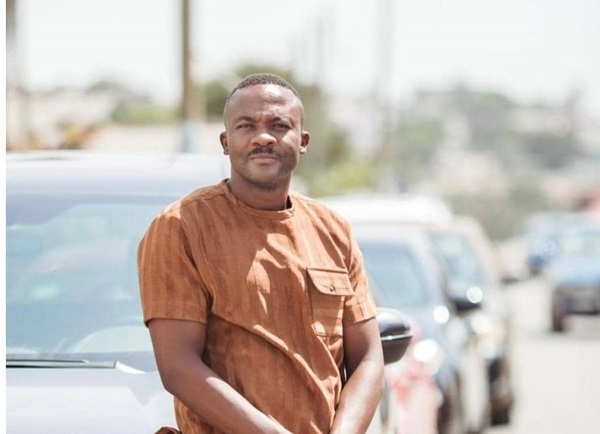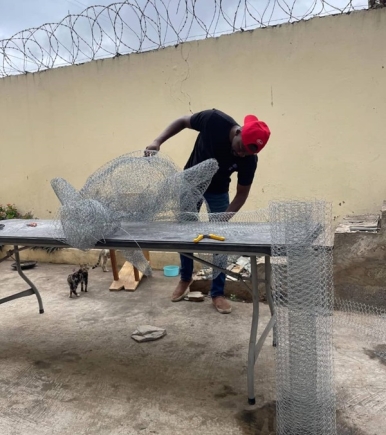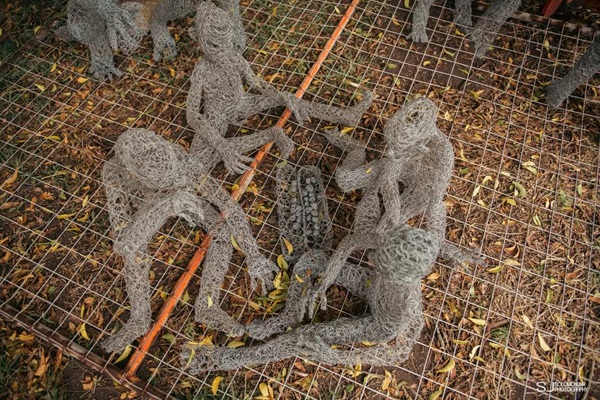
Weaving culture with wire: Unique art of Salim Wumpini Fuseini
Recently, a particular artwork captured the attention of many around Independence Square in Accra—a stunning installation made with wire mesh. Despite being packed in a truck, the wire mesh installations attracted a crowd, with onlookers gathering to admire and photograph the pieces from both near and far.
Curious to learn more about the creator behind this intriguing work, The Mirror followed up and discovered Salim Wumpini Fuseini, the artist responsible for the installation. In an interview, Salim, as he prefers to be called, shared insights into his artistic journey.
He revealed that his passion for art was cultivated during his secondary school and university years. “Art is a powerful medium for expressing emotions, ideas, and personal experiences. Many works of art address social and political issues, challenging viewers to think critically about the world around them. Art can be a form of protest, advocacy, or a call for change, influencing public opinion and societal progress,” Salim explained.
Journey into wire mesh installations
Although Salim has an academic background in art, he taught himself to create wire mesh installations just three years ago. “I have always wanted to create something unique with my skill, so I began experimenting with materials like used car tires, copper wires, and wire mesh.
Eventually, I settled on wire mesh, a common household material that is easy to source,” he said.
Throwing more light on the wire mesh, he explained that the wire mesh, also known as wire cloth or wire fabric, is a versatile material made from interconnected strands of metal that are woven or welded together to form a grid-like pattern. This pattern can vary in terms of the size of the openings (known as the mesh size) and the thickness of the wire used. Wire mesh is commonly made from materials such as steel, stainless steel, aluminum, copper, and brass.

Salim elaborated on why he chose wire mesh over other materials. Working with tyres required time-consuming washing and disinfecting, while copper wires and tyres did not produce the desired effect. In contrast, wire mesh is readily available, lightweight, and easy to handle. “The mesh has a distinctive colour tone and variation that makes it appealing to the eyes,” he added.
The time required to complete each installation varies based on its size and theme. Some pieces take three weeks, while others can take up to eight months. “There are times when I run out of ideas and need to pause and rethink before continuing, which can prolong the production process,” he shared.
Concept behind the installations
Salim's installations often explore themes related to family settings, values, and culture, areas he believes are increasingly influenced by foreign cultures with negative societal impacts. He explained that expatriates often come to Ghana searching for their roots, making it crucial for locals to uphold their cultural heritage.
“Art by nature helps preserve cultural heritage by maintaining the traditions, stories, and symbols of a community. It acts as a bridge between generations, ensuring that cultural identities are passed down and remembered,” he stressed.
One of his installations, for example, depicts traditional family settings, such as mothers carrying babies on their backs or braiding their children's hair. This highlights the multitasking nature of Ghanaian mothers.

He further added that in many Ghanaian communities, the family, particularly the extended family, plays a crucial role in raising and supporting children. “These artworks can be displayed in public spaces or galleries to educate and remind people of the importance of family,” Salim noted.
Aside from this, he said creating sculptures that represent family members, such as parents, children, and elders, can be a way to honour the family unit. These could be symbolic representations, like a mother holding a child or an elder guiding a younger person.
Last year, Salim held his first solo exhibition at Independence Square, drawing about 400 attendees due to the strategic location. The exhibition, themed “Revival,” marked his return to the art scene after a long absence. This year, he showcased his work at various exhibitions and carnivals and anticipates even greater opportunities next year.
Personal background
Born in Accra to Alhaji Fuseini Baba Seidu and Hajia Salamatu Mahama, Salim hails from Yendi in the Northern Region. His artistic journey began during his primary education at Service Basic School and continued at Adisadel College in Cape Coast, where he pursued Visual Art from 2005 to 2008.
![]()
His passion for the arts led him to study Fine Art at Kwame Nkrumah University of Science and Technology from 2009 to 2013.
Salim is the second of six siblings and is married to Naa Kooko Abbey. The couple have two sons, Farhan and Fareed. In his free time, Salim enjoys playing football with friends and studying the environment and people, which he says inspires his work.
Currently, Salim is focused on selling most of his mesh installations and aspires to gain recognition from prominent art galleries worldwide to make his mark on the international stage.
